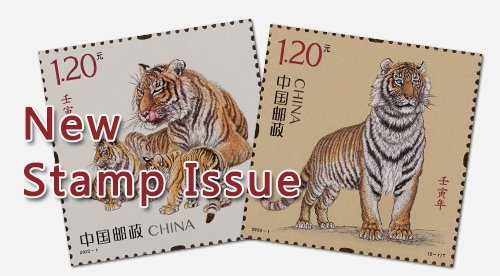 Postal Business: 8610 11185
Postal Business: 8610 11185Postal Savings: 8610 95580
Logistics and EMS: 8610 11183
China Post Life: 8610 4008909999
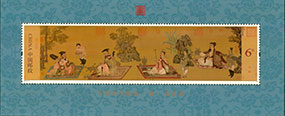 Cozy Worthies Map2016-6
Cozy Worthies Map2016-6Cozy Worthies Map is a painting by the Tang Dynasty (618-907 AD) artist Sun Wei. A rare figure painting from the dynasty, it is a colored painted scroll 168.7 cm long and 45.2 cm high. Kept at the Shanghai Museum, the Cozy Worthies Map is an incomplete copy of the Bamboo Grove Map, which captures seven worthies in the Wei and Jin dynasties (220-420 AD).
Yet the painting depicts four of the worthies: Shan Tao, Wang Rong, Liu Ling and Ruan Ji. Sitting on a tapestry, each has an expression in his own style. Four pages are waiting besides them with different objects in their hands.
Lacking an author's inscription, the painting carries the inscription of Song Dynasty Emperor Huizong (1082-1135 AD), "Cozy Worthies Map by Sun Wei". The painting was recorded in the Xuanhe Painting Book written in the Song Dynasty with the inscriptions "Xuanhe" and "Emperor's Handwriting".
In accordance, China National Philatelic Corporation will issue a FDC with sheet and cover.
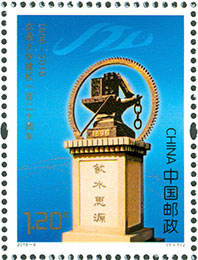 120th Anniversary Celebration of Jiaoton...2016-6
120th Anniversary Celebration of Jiaoton...2016-6Jiaotong University's predecessors are Nanyang College, Imperial Chinese Railway College and Beijing Railway Management Training Institute. Now it has five branch universities in Beijing, Shanghai, and Sichuan, Shaanxi and Taiwan provinces.
Taking the lead in running courses on telecommunications, railways, and management, the university has cultivated a large number of talents in the past 120 years, making a great contribution to the rejuvenation of the Chinese nation and human civilization.
In accordance, China National Philatelic Corporation will issue a FDC and commemorative postmark respectively.
 Nationwide Reading2016-8
Nationwide Reading2016-8April 23 of each year is World Reading Day. Coinciding with the 10th anniversary of China’s Nationwide Reading campaign, it has gradually helped reading become a social fashion.
Printed by special process, this set of stamps depicts "Three-Character Classic" and Chinese Braille "Nationwide Reading".
Light from an open window is visible under ultraviolet lamp.
A QR code for the National Digital Library is included on layout Ⅱ.
In accordance, China National Philatelic Corporation will issue a FDC and commemorative postmark respectively.
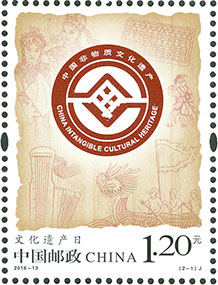 Chinese Cultural Heritage Day...2016-13
Chinese Cultural Heritage Day...2016-13Cultural heritage is a non renewable resource to pass on national historical culture and maintain the national spirit.
To protect cultural heritage can not only improve national unity but also maintain world cultural diversity.
China decided to set each year's second Saturday of June as cultural heritage day in December of 2005.
Themed "Integrating Cultural Heritage into Modern Life", June 11, 2016 is the 11th Chinese Cultural Heritage Day.
In accordance, China National Philatelic Corporation will issue a FDC and commemorative postmark respectively.
 Tangshan International Horticultural Exp...2016-9
Tangshan International Horticultural Exp...2016-9Themed "City and Nature-Phoenix Nirvana", Tangshan International Horticultural Exposition 2016 opened in South Lake Park of Tangshan, north China's Hebei Province on April 29.
Aiming to create an unforgettable event, the idea of the exposition centered on environmental protection, a low carbon lifestyle and harmonious interconnection between city and nature.
Coinciding with the 40th anniversary of the Tangshan earthquake, the event showcased reconstruction and restoration results achieved by the city, expressing local people's determination in environmental protection, ecological restoration and sustainable development.
The first set of stamps depicts the low carbon lifestyle pavilion, Tangshan Park, as well as a phoenix gracefully coming to rest.
The second set of stamps depicts the phoenix flying towards the sun and a phoenix flower fairy.
In accordance, China National Philatelic Corporation will issue a FDC and commemorative postmark respectively.
The exposition runs till October 16.
 China's Literal Classics - Dream of the ...2016-15
China's Literal Classics - Dream of the ...2016-15Dream of the Red Chamber, also called Story of the Stone, is a couplet novel composed by Cao Xueqin.
Based on the four wealthy aristocratic Jia, Shi, Wang and Xue clans and exploring the love tragedy between Jia Baoyu, carefree adolescent male heir of the family, and his sickly cousin Lin Daiyu. It covers the episodic prosper and decline of the two branches of the wealthy, aristocratic Jia clan - the Rongguo and Ningguo houses, who reside in two large, adjacent family compounds in the capital.
The plot concerns a variety of subject areas, such as poetry, ditties, odes, songs, music, chess, calligraphy, painting and other traditional forms of culture. With fine and vivid language, the novel has created many typical characters and is a remarkable artistic achievement.
In accordance, China National Philatelic Corporation will issue a FDC and commemorative postmark respectively.
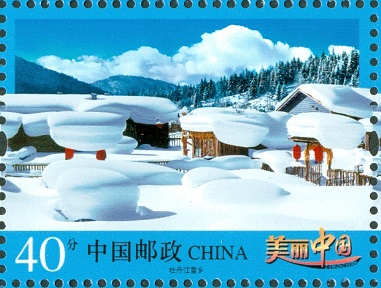 China (Ⅱ)2016-14
China (Ⅱ)2016-14Following the style of China (Ⅰ), this set of stamps includes scenery from various regions in China, revealing the natural beauty of mountains and the country's vast territory.
The Land of Snow at Bimodal Mountain, northeast China's Heilongjiang Province, represent snow-covered forests in winter.
Wanfeng Forest, in southwest China's Guizhou Province, reveals a characteristic Karst topography.
With deserts neighboring lakes, Sand Lake in northwest China's Ningxia Hui Autonomous Region shows an eco-friendly environment.
Located in east China's Zhejiang Province, West Brook Wetland, a national park, is rich in animal and plant life, and includes many scattered ponds and islands.
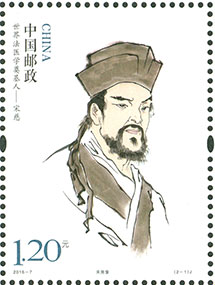 Founder of World Forensic Science Song C...2016-7
Founder of World Forensic Science Song C...2016-7Born in the city of Nanping of southeast China's Fujian Province, Song Ci (1186-1249), whose courtesy name is Huifu, self-titled Zimu, was an ancient forensic scientist. As a third-degree scholar of his time, Song was appointed judge of prisons four times. Accumulating a number of first-hand data in forensic examination and summarizing forensic knowledge of Song and previous dynasties, he authored Records for Washing away Wrong Cases. As the world's earliest forensic monograph, the book guided judicial practice in Song and following dynasties. Published 350 years earlier than similar books in western countries, it became a classic in international forensic history. Thus, Song has been recognized as founder of world forensic science.
In accordance, China National Philatelic Corporation will issue a FDC and commemorative postmark respectively.
 Modern Scientists of China...2016-11
Modern Scientists of China...2016-11It is the seventh issue of the Modern Scientists of China stamp series. With eminent achievements, the four scientists have made outstanding contributions to the development of modern Chinese science and education, occupying an important place in history.
Born in east China's Jiangsu Province, Ding Wenjiang was one of the founders of Chinese geological science.
Born in east China's Zhejiang Province, Jin Shanbao was an agronomist, agricultural educator and founder of the science of wheat.
Born in east China's Shanghai, Ye Qisun was a physicist and educator, a founder of modern Chinese physics, and a co-founder of China Physical Society.
Born in Tianjin, Ye Duzheng was a meteorologist, a founder of Chinese modern meteorology, pioneer in the study of global climate change and winner of National Top Science and Technology Award.
China National Philatelic Corporation will issue four FDC and a commemorative cancellation respectively.
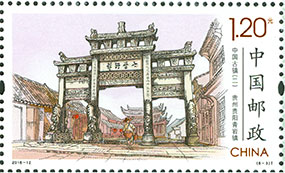 Ancient Towns of China (Ⅱ) - Special St...2016-12
Ancient Towns of China (Ⅱ) - Special St...2016-12The Eight Scenic Sights of Qin Lake presents Qintong Town as a typically beautiful area of rivers and lakes in northeast China's Jiangsu Province. Located at the foot of Dabie Mountain, Qiliping Town is a nationally famous red tourism resort. Qinyan Town, in southwest China's Guizhou Province, has been an important military base since ancient times. Zhujiajiao Town, located near the edge of Dian Mountain in Shanghai, is known as Small Shanghai. Sanhe Town, in east China's Anhui Province, is famous for the Eight Antiquities Scenic Sights, including ancient rivers, bridges, embanked fields, streets, houses, tea houses and battlefields. Last comes Huangyao Ancient Town, in south China's Guangxi Zhuang Autonomous Region, which is characterized by its unique Lingnan style.
Based on actual locations, the set of stamps embodies the culture heritage, steady history and beautiful scenery of the six ancient towns.
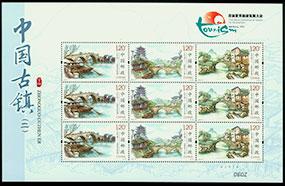
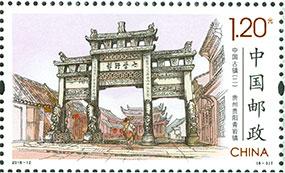
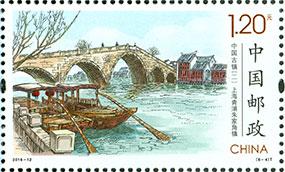

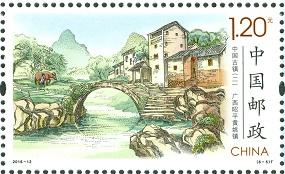
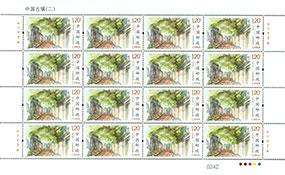

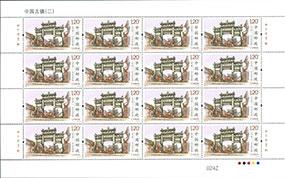
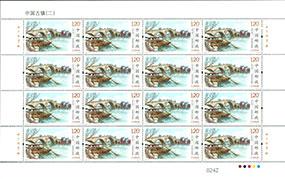
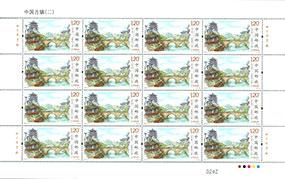
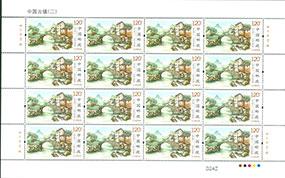

- 最前 上一页 1 2 3 4 下一页 最后
 Register number: 京ICP备15035540号 京公网安备110401400185号
Register number: 京ICP备15035540号 京公网安备110401400185号 Powered by CHINA POST | About Us | Sitemap | Contact Us |



